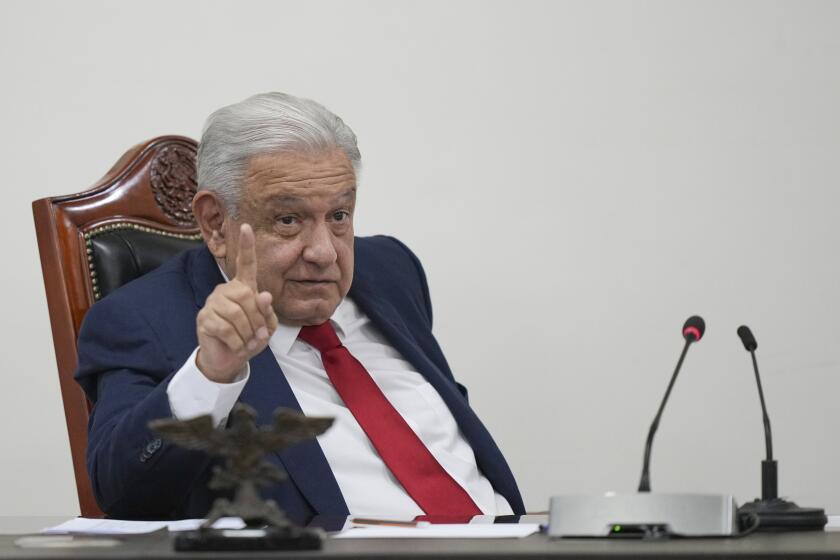A FEARSOME FORCE
Halfway through a new film about the history of rock ‘n’ roll in Mexico, grainy footage shows a stunned group of young people running down the street in retreat. Some stumble, and friends stop to try to pick them up. The film is silent, but the panic leaks through the fuzzy images.
You finally realize you’re watching people being shot and falling dead in their tracks. They are the victims of what became known as the Massacre at Tlatelolco, when authorities opened fire on demonstrators on the eve of the 1968 Olympics in Mexico City.
The soundtrack to the gruesome scene is “Abuso de Autoridad” (Abuse of Authority), a raw protest song by El Tri, one of Mexico’s most popular and enduring rock bands. In his raspy vocal, lead singer Alex Lora makes a sarcastic reference to the son of then-President Gustavo Diaz Ordaz, the counterculture villain who ordered the crackdown -- and whose son was an aspiring roquero.
“They lock you up if you protest, and now they even want to take away our rock concerts,” Lora growls. “The only one still allowed to play is the son of Diaz Ordaz.”
It’s the most gripping scene in the film, “Rock ‘n’ Roll Made in Mexico: From Evolution to Revolution,” which screens next week at the Fine Arts Theatre in Beverly Hills, to be followed by a live concert featuring veteran Mexican rockers. The film is one of the rare works in English to explore the tortured history of rock south of the border, a little-known story of how politics and paranoia conspired to snuff out a whole style of music -- and a way of life -- seen as a threat to social order and moral values.
The fear of rock as a corrupting force on youth was also common in the U.S. But in Mexico, according to the film, that fear was turned into an official policy of censorship and eradication. Officials banned the music from radio and TV, raided and closed nightclubs, stopped men on the street to shear their long hair, arrested fans and musicians en masse and forced the movement underground for almost two decades.
The movie is based on interviews with some of the music’s ‘60s pioneers, many now in their 60s, including Lora, Tijuana blues guitarist Javier Batiz and drummer Adolfo “Fito” de la Parra, the film’s co-producer, who came to the U.S. as a teenager and joined Canned Heat, the blues band he still leads. In their accented English, they recount how the music went from a pastime of the pampered elites to a cultural cause championed by the poor in Mexico City’s vast ghettos, where fans held clandestine concerts in warehouses and parking lots called “oyos funky,” or funky dives. The film essentially ends where the story for most people begins, with the music’s ultimate triumph in the ‘80s and the emergence of bands such as Cafe Tacuba and Maldita Vecindad.
The idea for the documentary grew unexpectedly out of a plan to make a movie from De la Parra’s self-published memoirs, “Living the Blues: Canned Heat’s Story of Music, Drugs, Death, Sex and Survival.” De la Parra’s early years in Mexican bands such as Los Sparks and Los Sinners pointed to an untold story that captivated his partner, producer-director Lance Miccio.
“I felt I had discovered something here that has been overlooked,” says Miccio. “Even kids in Mexico don’t know the trails that were blazed before Mana.”
He’s referring to the massively popular pop/rock band from the 1990s, which recently sold out four nights at Staples Center. Mexican rock is now part of the establishment -- the filmmakers don’t want that success to be taken for granted.
It started in the ‘50s and ‘60s, when clean-cut kids formed bands to make covers of Top 40 hits imported from the U.S. and Britain. They had names like Los Teen Tops, Los Hooligans and Los Rebeldes del Rock. The spirit was so innocent they managed to trivialize even a novelty song like “Hang On Sloopy,” which became “Hey, Lupe! Lupita, mi amor” in the hands of Los Rockin Devils.
By the early ‘70s, the movement had adopted the psychedelic styles of the hippie generation with one band calling itself simply Peace and Love. The movement peaked in 1971 with a festival that became known as the Mexican Woodstock, drawing 300,000 fans to Avandaro outside the capital. The event was peaceful, but politicians and the press demonized it as a gathering of sex-crazed druggies and anarchists. The music was banned with the help of government-controlled media, and it would take 15 years to get reestablished.
At the end of the film, it’s inspiring to watch concert footage of Lora and El Tri in 2002, with today’s Mexican teenagers earnestly mouthing the lyrics of social outrage in “La Epidemia” (The Epidemic), which denounces corruption. In Los Angeles, he can still pack the Sports Arena.
“I travel the world continuously, and I’ve never seen in any country a story as compelling as the story of Mexican rock,” says De la Parra, who now lives quietly in Santa Paula, surrounded by his rock memorabilia. “I mean, the Germans didn’t go to jail for playing rock ‘n’ roll.”
Miccio and De la Parra made their film on a meager budget of $30,000, and at times it shows. It has no narration, leaving the story to be spliced together from the interviews. That creates a muddled chronology and occasional redundancy. With such a compelling topic, why open the film with each musician recalling his first instrument, a litany of who played what and when?
The movie also leaves questions unanswered. If the 1968 crackdown was so severe, for example, how did promoters manage to organize that Mexican Woodstock just three years later? At one point, Batiz explains the crackdown in vague hippie language. “I mean, the flowers were starting to bloom, come on! So the [government] didn’t want that.”
Makes you yearn for an extra pundit or two. (The only non-musician interviewed is the informed rock historian Federico Rubli.) The film could benefit from a little more time and money, and Miccio acknowledges it’s a work in progress.
Yet, despite its faults, the film is compelling, especially for its vintage footage that includes police surveillance tape of demonstrations. On the eve of Coachella, which will feature two respected contemporary rock bands from Mexico, Porter and Austin TV, it’s good to remember the long and winding road that brought us here.
“Rock ‘n’ Roll Made in Mexico” screens at 7:30 p.m. Friday at the Fine Arts Theatre, 8556 Wilshire Blvd., Beverly Hills. Concert to follow. Admission is free. To RSVP for tickets, go to www.screenitfirst.com/ssg/events/rsvp/50.
--
More to Read
Sign up for Essential California
The most important California stories and recommendations in your inbox every morning.
You may occasionally receive promotional content from the Los Angeles Times.










